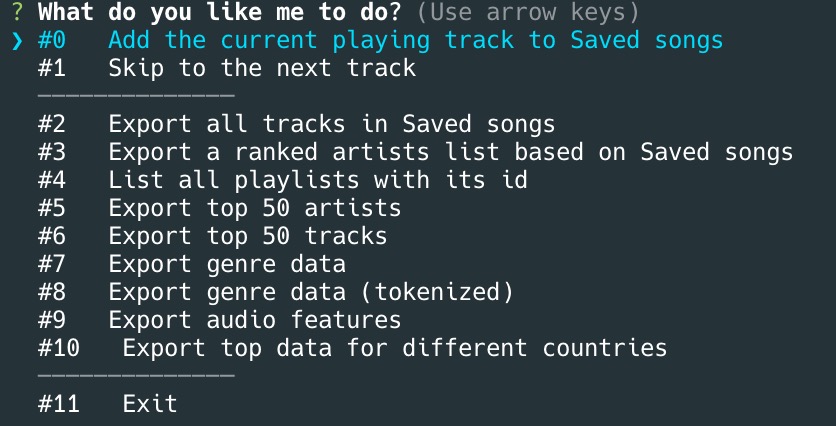spotify-lens v3.0.2
SpotifyLens
NB
So far the core functions I designed have all been implemented.
The last function I added is to export top data for different countries. And I have also initiated a sister project Spotioid to visualize these data, check it out if you are interested.
Issues may occure if the playlist is extremely large due to API call frequency restrictions by Spofity (as I am doing concurrent requests, and in that case it will be too many). I will fix this problem later(but not soon). But you can checkout the code in Worker case 10 where there is a solution for a similar problem.
If you found out any other bugs, please report on Github. PR is all welcomed.
This is a enhanced wrapper for Spotify-api. It provides a simple api to the data that otherwise have to be computed. Most of the methods extends the original track-oriented api to a playlist-oriented manner.
Along with the package also comes a interactive terminal interface with which these data can be exported to local .json file. In addition, some handy playback controls are integrated.
Features
- Interactive REPL terminal interface for controling over spotify and export data.

- Automatically refreshes access token in the interactive mode.
- Get concatenated & pruned (configurable) data of all (Say goodbye to 50 objects at a time!) tracks in a playlist. Concurrent requests garantees the execution is still fast even when the playlist is long.
For scalability, there is a generic method(
SpotifyLens.pageConcater) to retrieve any paged data in Spotify api. Say if you want to extend a new method to get concatenated album list of an artist, you can add a new method toSpotifyLenslike this:async getAllAlbums(artistId) { const tasks = await this.pageConcater(this.getArtistAlbums.bind(this))(artistId) const responses = await Promise.all(tasks) //... }Calculate a list of ranked artists from a playlist.
- Genre analyzation for a playlist.
- Playlist-oriented audio features analysis.
How to
Run interactively at the terminal
- Create a
.envfile containing these fields.
As for how to get secret and id, refer to the docs by Spotify.ClientID=YOUR ID HERE ClientSecret=YOUR SECRET HERE Port=3000 OutputDir=data Tracks=tracks Artists=artists Genres=genres AudioFeatures=audio_features - Clone the repository then
npm installORnpm i spotify-lens. node run.jsand follow the instrcutions on the terminal.
Just use the core api
npm i spotify-lens- Manage the authentication yourself and then you can use the methods.
API
Worker
The Worker class provides authentication flow and cli.
SpotifyLens
The SpotifyLens class provides core functions, and is well-suited to be embeded into exsiting web services. It depends on lodash, spotify-web-api-node and chalk(for logging).
Available methods
- Since the core is an extension from
spotify-web-api-node, any methods fromspotify-web-api-nodeare still valid! getAllTracks(playlistId)returns all tracks found in the playlist withplaylistId.analyzeGenre(playlistId)examines the artists in the playlist wtihplaylistIdand return a counted genre representation.
[
//...
{
"count": 82,
"name": "tropical house"
},
{
"count": 60,
"name": "dance pop"
},
//...
]analyzeGenreTokenized(playlistId)is similar toanalyzeGenrebut will tokenizetropical housetotropicalandhouse.getAllArtists(playlistId)returns a ranked artists list whose works are found in the playlist withplaylistId. The artists are ranked by the number of works included in the playlist. So with this api you can analyze for example who are your favorite artists.analyzeAudioFeatures(playlistId)returns an overall average of features:'danceability','energy','key','loudness','mode','speechiness','acousticness','instrumentalness','liveness','valence','tempo'.
[
{
"name": "key",
"value": 6.919607695008806
},
{
"name": "loudness",
"value": -6.809477846428727
},
{
"name": "mode",
"value": 0.2117378077248013
}
//...
] For the methods above, if playlistId is undefined, it will target at the Saved Songs library.
addCurrentadds the currently being played track to the Saved Songs library.getAllPlaylistsreturns current users' all playlists and the corresponding id.getTopArtists({ limit = 50, offset=0 })returns the spotify personalization information about top artistis. Same logic applies togetTopTracks({ time_range, limit, offset })NB This is different from the default beheavior as specified by Spotfiy documentation. According to documentation from Spotify, thetime_rangeis set tomid_termas default value. However, this function return data in all three time ranges. The returned value look like this:
{
"long_term": [
{
//...
"genres": [],
"id": "4KXp3xtaz1wWXnu5u34eVX",
"images": [],
"popularity": 62,
"type": "artist"
}
// ...
],
"mid_term": [
{
//...
}
],
"short_term": [
{
//...
}
]
}Configure
In the config.js, you can configure some beheavior of the api.
PRUNE_***_KEYScontains the keys to be deleted when a***object is fetched from spotify api.SPOTIFY_SCOPEScontains the scopes required for Spotify API.PROMPTcontains the cli.
Roadmap
- Customize keys to export on objects.
- Top artists/tracks.
- Genre data.
- Reorgnize code to be more maintainable.
- Playlist audio features analysis.
- Rewrite the project in Typescript.
6 years ago
6 years ago
6 years ago
6 years ago
6 years ago
6 years ago
6 years ago
6 years ago
6 years ago
6 years ago
6 years ago
6 years ago
6 years ago
6 years ago
6 years ago
6 years ago
6 years ago
6 years ago
6 years ago
6 years ago
6 years ago
6 years ago
6 years ago
6 years ago
6 years ago